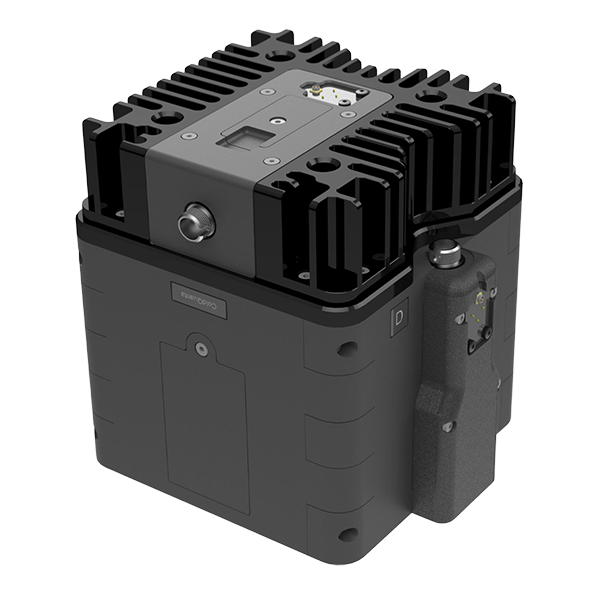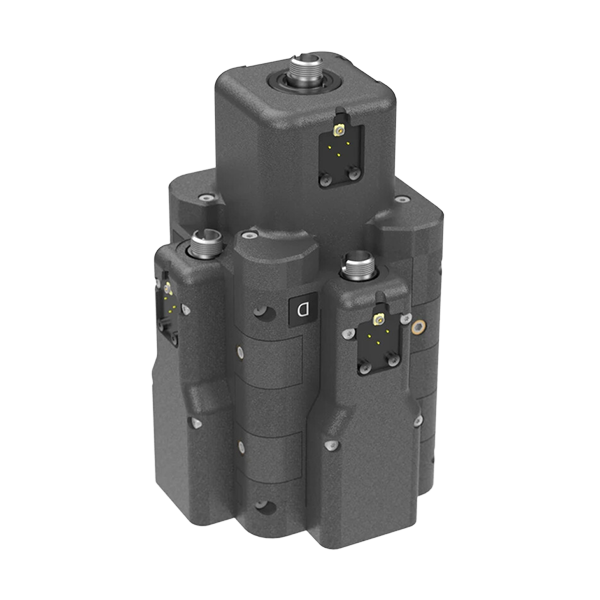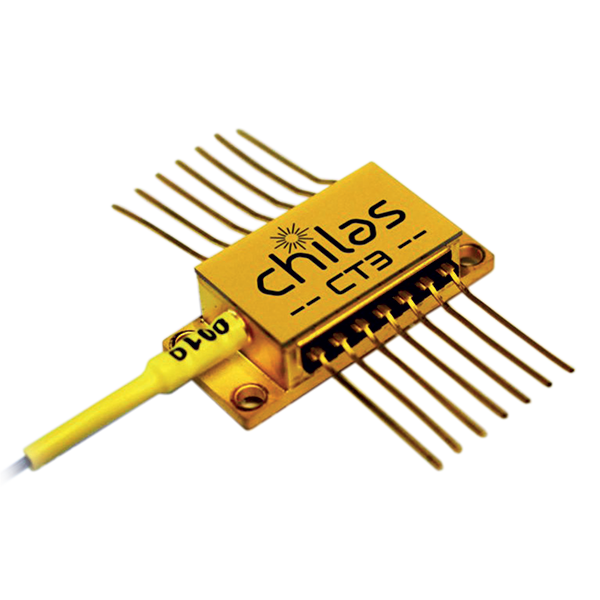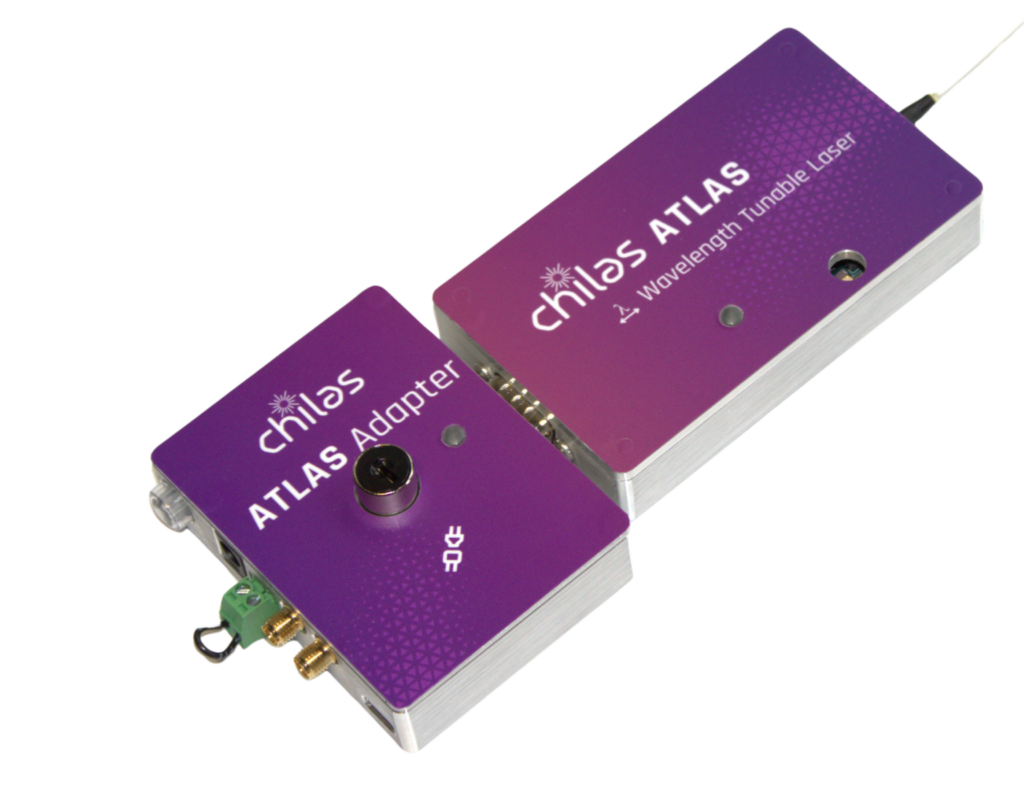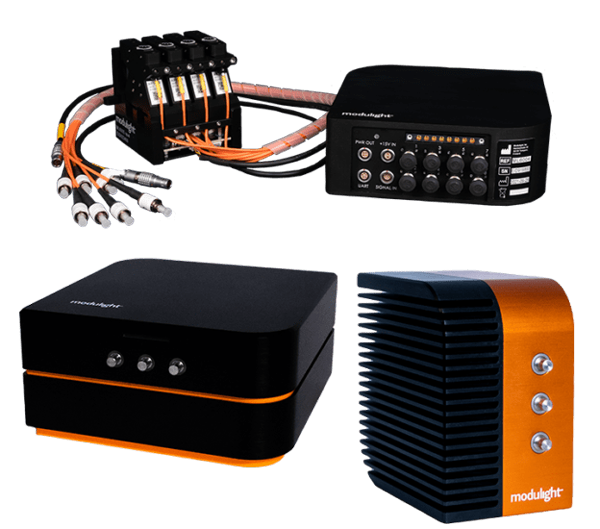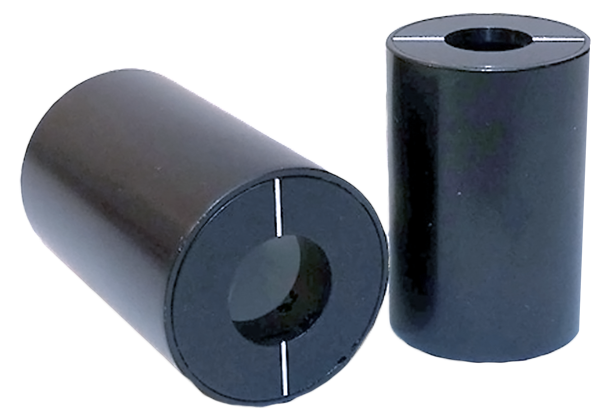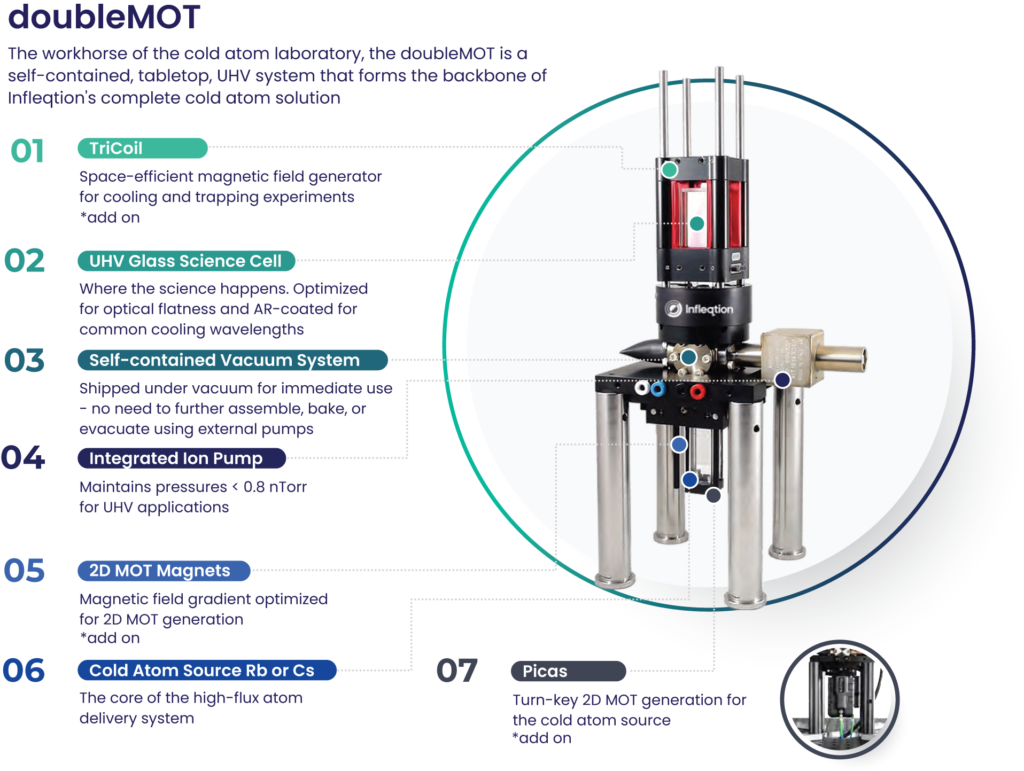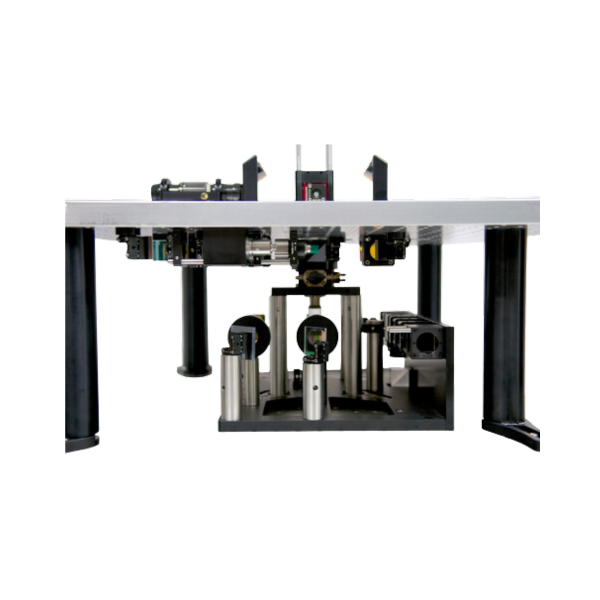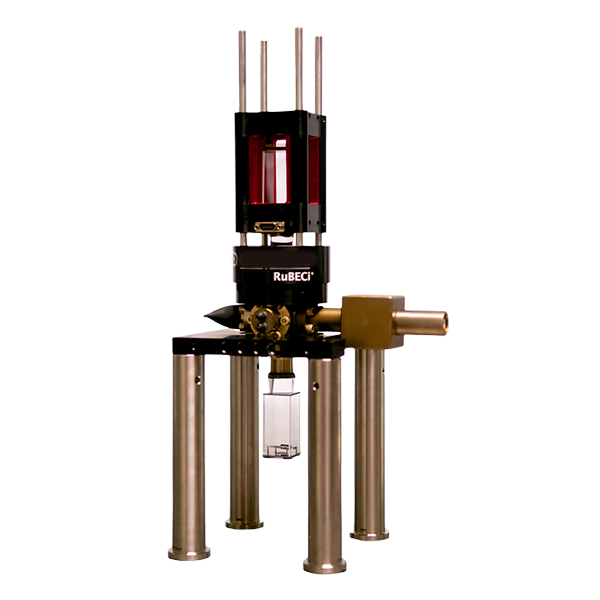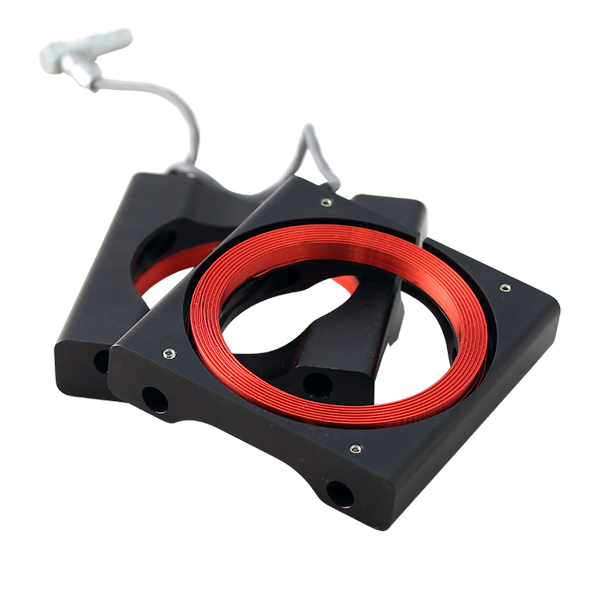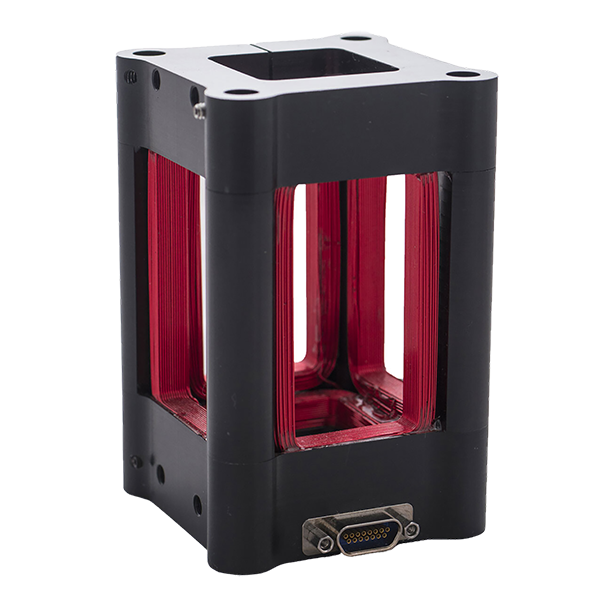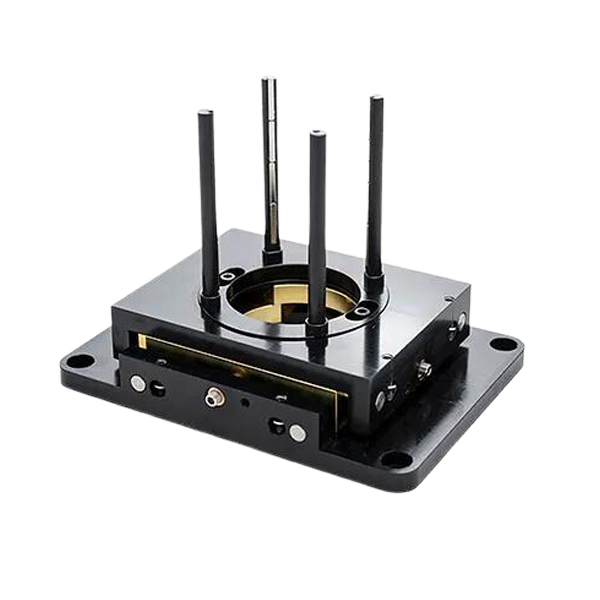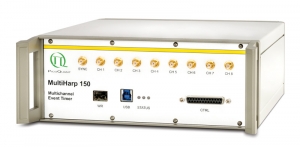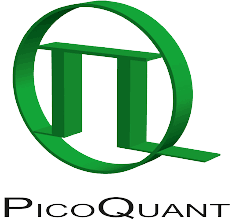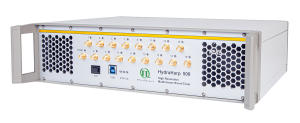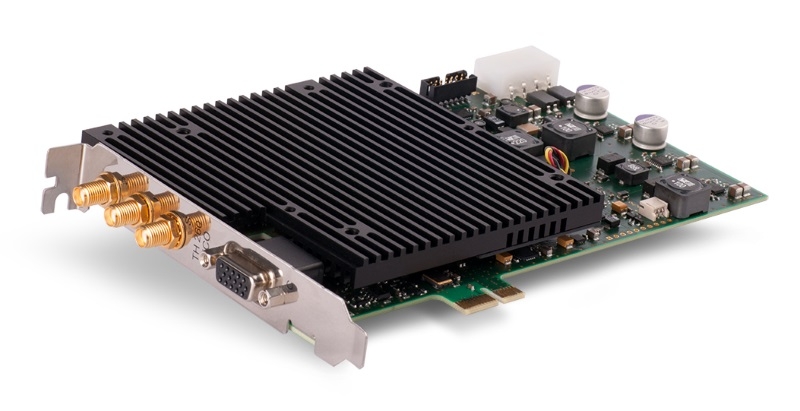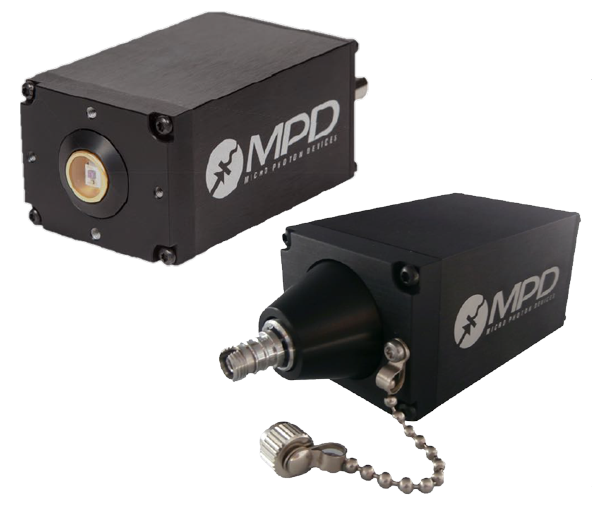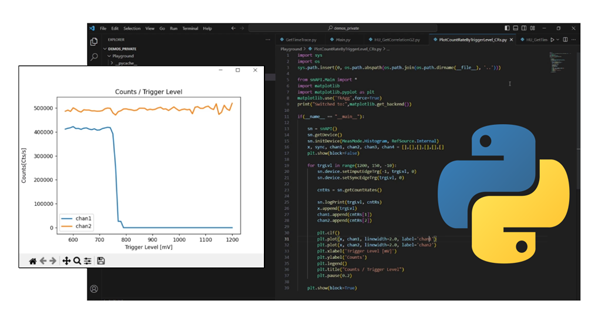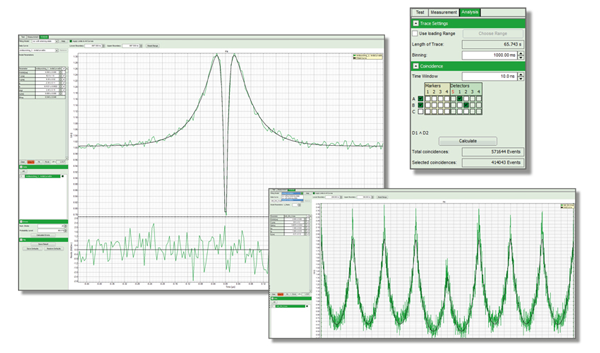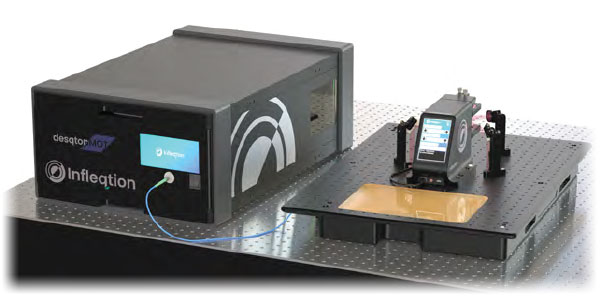
Discover Cutting-Edge Tools for Your Quantum Photonics Experiments
Laser 2000 works with world-leading suppliers to provide a complete solution for cold atoms research





Sources & Beam Alignment
Selecting the Right Laser Source for Quantum
In the realm of quantum technologies, selecting the appropriate laser source is crucial for achieving precise control and manipulation of atomic states. The choice of laser wavelength is fundamentally determined by the specific atomic transitions required for applications such as laser cooling, trapping, and quantum state preparation.
The lasers and electro-optical subsystems capable of enabling these quantum technologies must deliver a high quality of light including stabilised laser frequency, optical power, polarisation and high quality beam characteristics, such as mode quality and beam pointing.
The precision of these wavelengths ensures effective interaction with the atomic transitions, enabling the cooling and trapping processes essential for maintaining coherent quantum states.
Packaging aspects including photonic integrated circuits and fibre-coupled operation enable tight integration with the sensor and supporting electro-optical subsystems.
Advanced laser systems, such as diode lasers, fibre lasers, and solid-state lasers, are often employed due to their high stability and tunability.
Ultimately, the meticulous selection of the right laser source, tailored to the atomic species and the desired quantum application, is pivotal in advancing the capabilities of quantum technologies.
Below is a table of common transitions and wavelengths:
| Atom/Ion | Transition | Wavelength (nm) |
|---|---|---|
| Rubidium (Rb) |
D1 line (5S1/2 to 5P1/2) D2 line (5S1/2 to 5P3/2) |
794.8 780.2 |
| Caesium (Cs) |
D1 line (6S1/2 to 6P1/2) D2 line (6S1/2 to 6P3/2) |
894.3 852.1 |
| Strontium (Sr) |
1S0 to 3P1 (cooling) 1SO to 1P1 (cooling) |
689.2 461.0 |
| Ytterbium (Yb) |
1SO to 3P1 (cooling) 1S0 to 1P1 (cooling) |
556.0 398.9 |
| Potassium (K) |
D1 line (4S1/2 to 4P1/2) D2 line (4S1/2 to 4P3/2) |
770.1 766.7 |
| Sodium (Na) |
D1 line (3S1/2 to 3P1/2) D2 line (3S1/2 to 3P3/2) |
589.6 589.0 |
| Calcium (Ca) |
1S0 to 1P1 (cooling) 1SO to 3P1 (intercombination) |
423.0 657.5 |
| Ytterbium Ion (Yb+) | 2S1/2 to 2P1/2 (cooling) | 349.0 |
| Magnesium (Mg) | 1S0 to 1P1 (cooling) | 285.2 |
| Mercury (Hg) | 1SO to 3P1 (cooling) | 253.7 |
| Aluminium (Al) | 2P1/2 to 2S1/2 (cooling) | 396.1 |
Coil and Fixed PICAS
By using Infleqtion’s Coil Picas, you can easily integrate optics into your Coil Picas Mount Assembly for a 2D+ MOT system with a tunable magnetic field. This system is perfect for those who are looking for a complete MOT and BEC solution for their lab. Additionally, the optional photodiode configuration provides polarisation cleaning and power monitoring capability for all three beams.
The Fixed Picas is a compact, alignment-free beam delivery package. It produces a 2D+ MOT beam configuration with three user-supplied fibre-coupled light inputs, capable of producing a cold atom flux of >10⁹ atoms per second when used with Infleqtion’s well-established CASC, Cold Atom Source Cell. The unit is easily integrated into the MAG-2000 magnet assembly, allowing a simple plug-and-play optical package.
An optional photodiode configuration provides polarisation cleaning and power monitoring capability for all three beams.
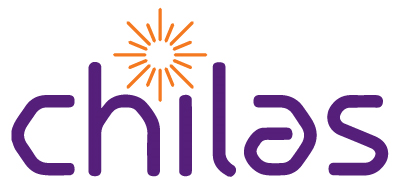
Hybrid Photonic Integrated Circuits from Chilas
Chilas lasers combine the best of III-V semiconductor and silicon nitride (Si3N4) technologies and have distinct advantages over DFB lasers, of which the most important are ultra-narrow linewidth, very wide tuning range, and small footprint.
All lasers come in a standard 14-pin butterfly package, equipped with a Peltier element. The output fibre is PM with an FC/APC connector.
Other packages and fibres can be made available upon request.
| CT3 | CF3 – 1550 nm | VT3 – 680 nm | BT3 – 850 nm |
|---|---|---|---|
| < 10 kHz linewidth | < 10 kHz linewidth | < 10 kHz linewidth | < 10 kHz linewidth |
| > 20 mW output power | > 10 mW output power | > 3mW output power | > 3 mW output power |
| C-band tunability | 1550 nm wavelength | 680 nm wavelength | 850 nm wavelength |
| Proven long-term reliability | Proven long-term reliability | Proven long-term reliability | Proven long-term reliability |
| Built-in TEC | Built-in TEC | Built-in TEC | Built-in TEC |
| PM pigtail | PM pigtail | PM pigtail | PM pigtail |

Modulight solutions for Quantum Computing
As explained above, quantum computing requires stabilised
low-noise narrow-linewidth lasers. The ML6600 platform for quantum applications includes a high stability low-noise driver, high stability temperature controller, and improved isolation against external perturbation.
- Preventive maintenance with predictive analytics and machine learning algorithms: Analyses laser diode performance, predicts future failures, and ensures high up-time
- Broad range of wavelengths from UV to 2+ μm, enabled by diode, solid state, and fibre laser technologies.
- All manufactured in-house at Modulight fab
- Technology roadmap towards Photonic Integrated Circuits
| Product | Description |
|---|---|
| ML6600 | Generic, cloud-connected ML6600 product platform with support for wavelengths ranging from UV to 3000+nm. The ML6600 platform can host multiple lasers of different wavelengths, or simply just one wavelength. |
| ML6600 – 349 nm UV laser | This free-space ML6600 is a UV laser source with a free-space output. Thanks to the versatility of Modulight ML6600 platform, the light delivery and other features can be tailored. |
| ML6600 – 355 nm UV laser | This ML6600 laser provides UV laser light to fill the requirements of quantum computing, semiconductor inspection, metrology, and microscopy applications. |
| ML6600 – 493 nm laser | This adaptation of the ML6600 platform is using VECSEL technology and intended for Ba+ trapped ion cooling in Quantum Computing applications. |
| ML6600 – 532 nm laser | Powered with our in-house VECSEL technology, this ML6600 is designed for Quantum Computing application acting as a Ba ion gene seed laser. |
| ML6600 – 553 nm laser | ML6600 product purposed for two-step photoionisation of neutral Barium, and based on Modulight’s VECSEL technology. |
| ML3302 – 760 nm DBR laser | This chip-on-submount DBR laser product can be tailored to be a part of a sub-system, such as the ML6600 platform. The laser is based on Modulight’s in-house DBR laser technology. |
| ML3303 – 780.2 nm DBR laser | Distributed Bragg Reflector single-frequency laser utilising Modulight’s in-house DBR laser technology. It is a chip-on-carrier product, which can be included as a part of the ML6600 platform. |
| ML3304 – 795 nm DBR laser | This DBR chip-on-submount laser is integratable in the ML6600 platform, and is based on Modulight’s in-house DBR laser technology. |
| ML3305 – 935 nm DBR laser | ML3305 is a DBR laser chip-on-submount product featuring Modulight’s in-house DBR laser technology. Ask our Sales team about tailoring your ML6600 based products to include this laser. |
| Laser core for ML6600 760 nm single-frequency laser | This ML6600 single-frequency, narrow linewidth laser system centred at 760 nm for Yb F repumping is based on Modulight’s ML3302 DBR laser diode, offering high beam quality and low intensity noise. |
| Laser core for ML6600 780 nm single-frequency laser | This ML6600 single-frequency, narrow linewidth laser system centred at 780 nm is well-suited for Rubidium D2 line absorption spectroscopy and it is based on Modulight’s ML3303 DBR laser diode, offering high beam quality and low intensity noise. |
| Laser core for ML6600 795 nm single-frequency laser | This ML6600 single-frequency, narrow linewidth laser system centred at 795 nm is designed for Rubidium D1 line absorption spectroscopy, and based on Modulight’s ML3304 DBR laser diode, offering high beam quality and low intensity noise. |
| Laser core for ML6600 935 nm single-frequency laser | This ML6600 single-frequency, narrow linewidth laser system centred at 935 nm for Yb D repumping is based on Modulight’s ML3305 DBR laser diode, offering high beam quality and low intensity noise. |
Laser Cooling
Laser cooling is a technique used to slow down the movement of atoms and other particles, allowing them to be trapped and manipulated with greater precision. This technique is crucial for many applications in physics and engineering, including quantum computing, atomic clocks, and precision measurements.
The basic idea behind laser cooling is to use lasers to exert a force on atoms that slows down their motion. When an atom absorbs a photon of light, it gains momentum in the direction of the photon’s travel. By carefully tuning the frequency and intensity of the laser light, atoms can be manipulated to absorb and emit photons in a way that slows down their overall motion.
One common technique for laser cooling is known as Doppler cooling, which is used to cool atoms that are moving quickly relative to the laser. In Doppler cooling, the frequency of the laser light is tuned slightly below the resonant frequency of the atom. When an atom moving towards the laser absorbs a photon, it is pushed backwards, reducing its velocity. When using multiple lasers in different directions, cooling of atoms in all three dimensions is possible.
Another technique for laser cooling is known as Sisyphus cooling, which is used to cool atoms that are already moving slowly. In this technique, the laser light is tuned to a frequency that is slightly off-resonant with the atoms. When an atom absorbs a photon, it gains a small amount of energy and is pushed to a slightly higher energy level. However, the atom quickly loses this energy due to collisions with other atoms and emits a photon in a random direction. This process repeats many times, effectively trapping the atom and cooling it down.
Optics and Polarisation Solutions
Optical Filters for Quantum
Quantum computing based on trapped ion qubits uses lasers for ionisation, cooling, positioning, entanglement, and state readout.
Semrock® optical filters play pivotal roles in quantum computing by enabling the use of precision lasers. As several laser lines may be needed to manipulate ion qubits, with wavelengths and specifications related to excited ions (e.g., 363/367/369/556 nm), the need for customised optical filters can be critical.
Semrock Optical Filters for Quantum Applications
Key Features and Recent Innovations
- Short production lead times of 4 weeks including customised design
- High transmission of up to 95% at specific laser wavelengths
- Wavelength precision: Advanced thin film coating process control ensures Precise Edge Placement, industry-leading spectral edge position repeatability as good as ±0.1% (e.g., ±0.5 nm at 500 nm) within and between production coating batches.
- High Edge Steepness: Narrow transitions between high transmission and deep blocking to separate laser lines as close together as 2 nm. An example measured spectral edge is shown in the graph.
- Multiple laser passbands on a filter
- Angle ranges of up to ±7° with minimal spectral shift
- Industry-leading precise metrology through our KolaDeep™ Spectral Measurement System
- Edge Steepness resolution: ~0.1% relative to the edge wavelength from T = 90% to OD 3/
- Deep blocking measurements: Up to OD 8-9 across UV, visible, and NIR ranges, with spectral features to OD 11

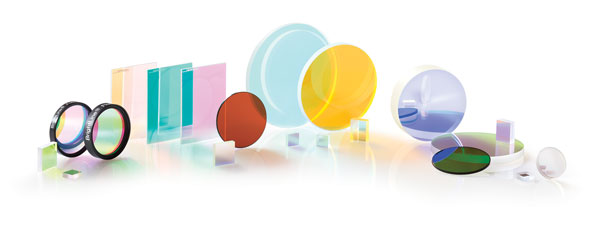
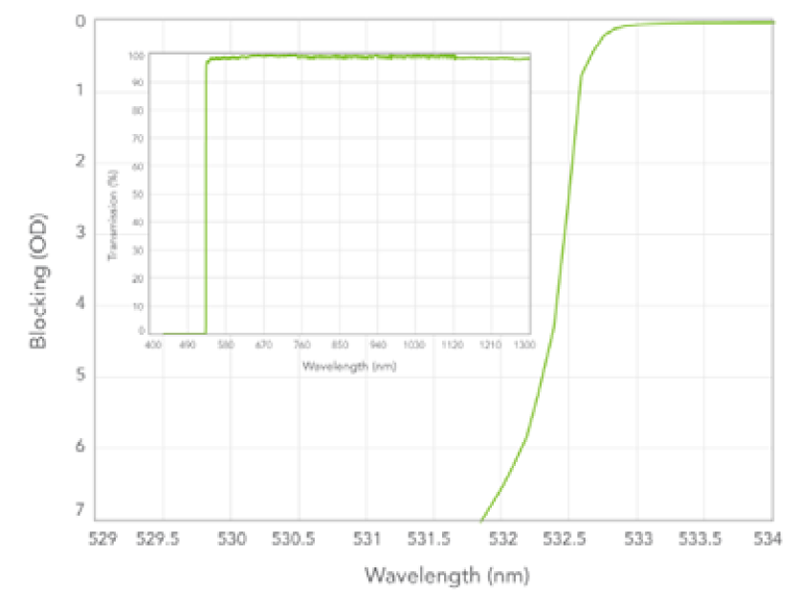
- Durability and reliability: All filters withstand extremes of temperature and humidity and come with a 10-year performance guarantee.
- Hard-coated thin-film filters with high Laser Damage Threshold (LDT)
Polarisation Solutions
A polariser is a type of optical filter that only allows light waves of a certain type to go through, while blocking other types. It can turn a mixed or undefined light beam into a clear, polarised light beam. There are two main kinds of polarisers: linear and circular. They’re used in many areas such as photography, LCD technology, and various optical tools.
Not only for visible light, polarisers can also work with other electromagnetic waves like radio waves, microwaves, and X-rays. Linear polarisers can be absorptive, which means they absorb unwanted light types, reflective, which means they reflect unwanted light types, or beam-splitting, which means they break the light beam into two opposite types. Circular polarisers can make circularly polarised light or selectively let through or block light that’s spinning clockwise or counter-clockwise. Meadowlark offers both linear
and circular polarisers.
- Wide Range of Options – Circular, Linear, & Beam splitting.
- Broad Wavelength Capabilities – Our standard polarisers are designed for use in the 220 nm to 6 micron range (with custom options up to 15 microns.)
- High Quality and Precision – Meadowlark Optics is proud to provide our customers with industry-leading specifications including excellent surface quality, high extinction ratio, low transmitted wavefront distortion, and more.
- Custom Solutions – Prism clusters, attached retarders, odd shapes and sizes – while we are delighted to provide you one of our standard components or systems, we are just as happy to customise a solution that more exactly fits your needs.
Atomic Prisms
UHV glass cells with AR coatings optimised for common cooling wavelengths and superior flatness performance.
2 cm AR Coated Cells
Infleqtion’s high-quality glass cells offer a new level of optical access to in-vacuum experiments. Assembled with an optical contacting process the cells provide high-quality AR coatings while maintaining very high optical flatness in the cell walls, enabling minimal optical distortion through the cell. The cells are connected to the flange through an anodic bond to a silicon transfer, and have no epoxy or frits, giving them excellent outgassing properties.
High-NA Imaging Cells
This cell family is designed to be used with readily available microscope objectives, including the G Plan APO 20x and 50x ULWD objectives from Mitutoyo, which allow the user to access samples at 0.3 and 0.5 NA, respectively. The cell is fabricated to ensure excellent parallelism between the two large faces, making it possible to image or project light through two faces of the cell with almost no astigmatism.
| AR Coated Cells | |
|---|---|
| Nominal ID Dimensions |
2 cm Cells: 20 ± 0.5 mm x 60 ± 1 mm High-NA Cells: 10 mm x 13 mm x 60 mm |
| Optical Flatness | < λ/2 per cm peak-valley flatness |
| Wall Thickness |
2 cm Cells: 3 mm ±0.05 mm High-NA Cells: 3.5 mm ±0.05 mm |
| Top/bottom face parallelism | 1 arcminute |
| AR Coating, 2 cm Cells | IBS AR coating. Stocked as Broadband (BB) or targeted for rubidium, caesium, potassium, and optical trapping at 1064 nm (CRK). |
| AR Coating, High-NA Cells | IBS AR coating. Stocked with targeted coating for rubidium, caesium, potassium, sodium, and optical trapping at 532 and 1064 nm. Uncoated cell also available. |
| Temperature Range | Up to 300 °C |
| Vacuum Connection | DN16 (1.33”) or DN40 (2.75”) CF flange |

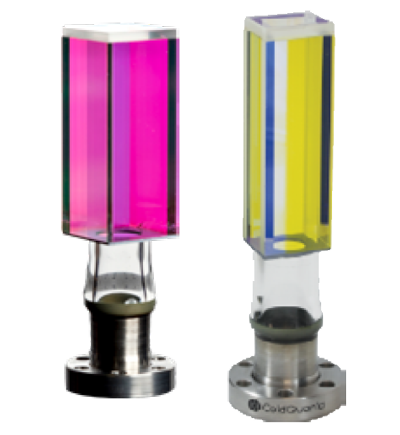
- Ultrahigh vacuum cell
- Anti-reflection coated on inside and outside surfaces of all cell walls
- Bakeable to high temperatures
- Epoxy-free and frit-free assembly
- Optically matched to readily available objectives at 0.3, 0.5, and 0.7 NA
- Ultrahigh vacuum cell
- Anti-reflection coated on inside and outside surfaces of all cell walls (uncoated available)
- Bakeable to high temperatures
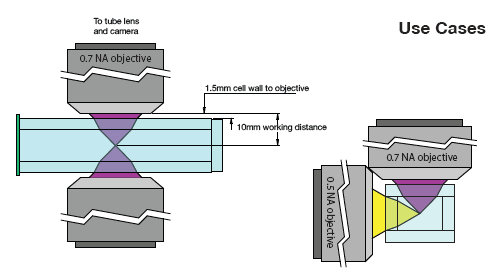
Cold Atom Source Cells (CASC)
Product Features:
- Dual alkali metal sources
- 2D+ MOT capable
- Pinhole for differential pressures
- Assembled without epoxies or frits
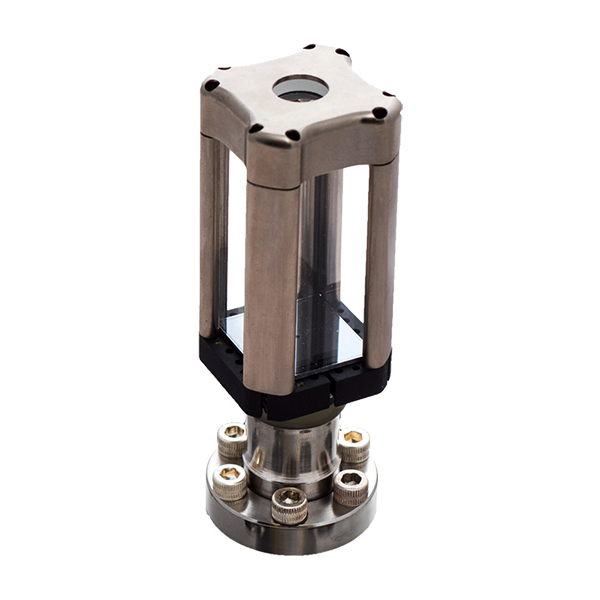
Magneto-Optical Trap Systems
miniMOT V2
The miniMOT V2 is a stand-alone, compact, ultra-high vacuum (UHV) trapped atom system equipped with an intuitive user interface designed to allow users to create quantum matter for immediate implementation in any research experiment, teaching laboratory for academic development and workforce training, or as a dedicated UHV system for prototype cold atom product development in computing and sensing applications.
Equipped with our standard thin-walled UHV glass cell, integrated ion pump, electronic drivers for the atom dispenser, and magnet coil assemblies, the miniMOT V2 enables the creation of rubidium (Rb) or caesium (Cs) magnetic optical traps (MOTs) at the touch of a button. The miniMOT V2 can also be configured with AR coated UHV glass cells to meet your specific needs.
When paired with miniMOT Package and MOT Coils, users can align all laser beams entering the UHV glass cell and obtain precise control of magnetic fields for easy and controllable MOT generation of up to 108 cold atoms1.
The miniMOT V2 removes the need to establish large and expensive vacuum chamber equipment and the system can be installed and set up to create cold atom MOTs in a matter of hours, not weeks. All miniMOT V2 products are subjected to final quality inspection testing, including a fluorescence measurement to confirm vacuum conditions are as specified, and Rb (or Cs) vapour is present in the cell. Each miniMOT V2 comes with a certificate of conformance indicating the minimum current through the alkali metal dispenser to discern fluorescence.
Achieve a live MOT within hours rather than months.
Features
- Compact UHV system suitable for MOT production from a background vapour
- Active and passive pumps to maintain vacuum quality over several years of operation2
- Integrated electronics for vacuum control, alkali atom pressure control and to drive the miniMOT coils
- Touchscreen interface for seamless user control of system operation
- Shipped under vacuum and ready for immediate use
Options
The miniMOT V2 has been designed for the following alkali metal sources:
- Rubidium (Rb)
- Caesium (Cs)
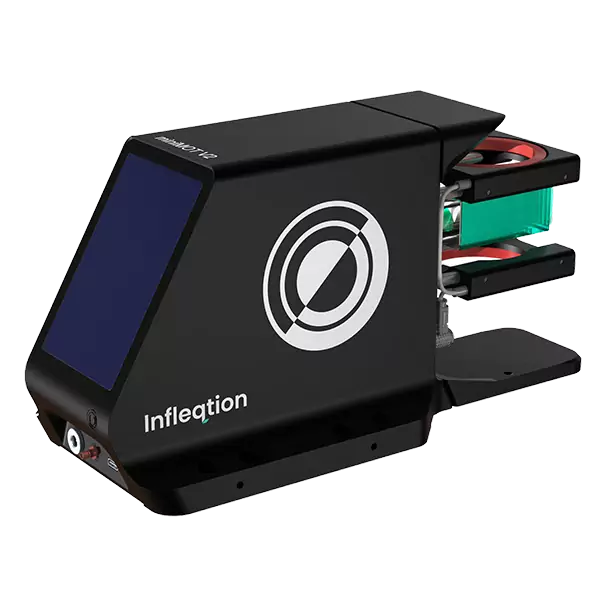
| Specifications and Testing | |
|---|---|
| Vacuum Quality* | <1 x 10-8 Torr |
| Cell Clear Aperture** | 54 x 19 mm (side walls), 10 mm dia. min. (end cap) |
| Magnetic Field Gradient*** | 13-14 G/(A-cm) |
| External Dimensions | 149 × 119 × 298 mm |
| Centre Cell Height | 89 mm |
| Weight | 3.3 kg |
1 Under certain experimental conditions.
2Running under normal operating conditions, the vacuum quality will last ~5 years.
*Without alkali load.
**When equipped with a standard 2 cm Thin-Walled glass cell.
***This is the gradient along the coil axis and when using Infleqtion’s miniMOT Coils (CAMCMM).
For complete system specifications see miniMOT V2 User Manual.
miniMOT Package
Introducing the miniMOT package, the ultimate solution for producing a compact and efficient magneto-optical trap (MOT). Our pre-assembled unit is easy to use and produces a live MOT within a few hours, saving both time and cost for even the most seasoned researchers. The package includes a 15”x18” aluminium breadboard with a periscope/beam-splitting/polarisation assembly, mirrors for easy trap alignment, and a small B&W CCD camera for MOT imaging. The miniMOT package is not only ideal for teaching laboratories to introduce students to lasers, optics, and quantum matter, but also for quantum information experiments.
Features:
- miniMOT V2 and optics package to enable the production of a MOT
- Pre-aligned for rapid deployment
- Compact footprint for any laboratory benchtop
- Get in touch to learn more about suitable laser options for your system
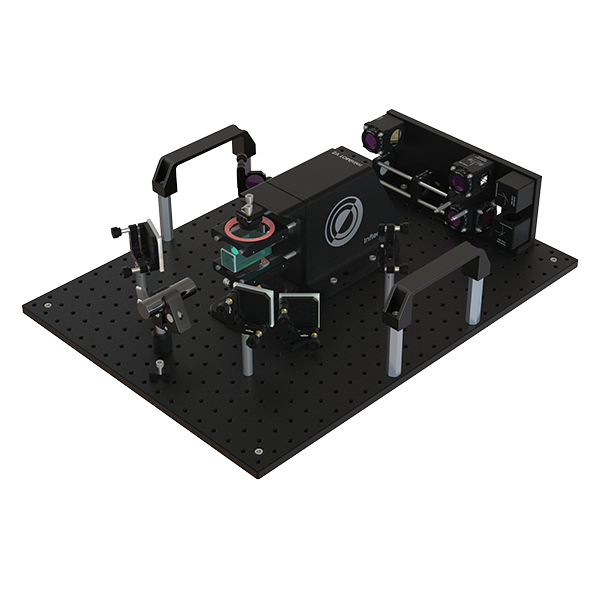
doubleMOT
- Ultrahigh vacuum system
- Active and passive pumps to maintain vacuum
- Two MOT operation for improved vacuum and control
- Assembled without epoxies or frits
The workhorse of the cold atom laboratory, the doubleMOT is a self-contained, tabletop, UHV system that forms the backbone of Infleqtion’s complete cold atom solution.
The system can be used for a wide variety of projects, ranging from basic research in quantum physics to the development of sensors and new technologies that are based on cold atoms. The doubleMOT utilises two chambers, isolated by a silicon pinhole disc: a lower chamber to achieve high atom number, and an upper chamber to maintain an ultra-high vacuum. A rail system allows for easy integration of Infleqtion’s magnetics management products. The doubleMOT is shipped permanently under vacuum and ready to be placed into an appropriate apparatus such as the Infleqtion Physics Station or Physics Platform.
Physics Platform
The Physics Platform provides the foundation optics for experiments, including a 3D magneto-optical trap (MOT) fed by a 2D+ MOT. It also includes optics for optical pumping and imaging neutral and ultracold atoms in the science cell. It consists of two stages: 2D+ MOT hardware and a six-beam MOT stage to create a 3D MOT in the science cell. The Physics Platform provides the user with increased flexibility to modify and adapt the system.
Features:
- Optics package to complement the RuBECi® or doubleMOT systems
- Highly flexible configuration
- Includes optics and opto-mechanics for 2D(+) MOT, 3D MOT, optical pumping, and imaging
- Pre-aligned for rapid deployment
- FC/APC Fibre inputs
Wavelength Selection
767 nm / 780 nm / 852 nm
RuBECi
The RuBECi is a self-contained, tabletop, ultrahigh vacuum system for creating and manipulating ultra-cold atoms. It utilises a two-cell vacuum system (a 2D+ MOT source cell and an ultra-high vacuum science cell compatible with long trap lifetimes). It features an atom chip for simple and rapid BEC production with a high-duty cycle and low power consumption. High numerical aperture imaging of trapped atoms in the chip potential is possible thanks to the atom chip’s integration into the science cell wall. The RuBECi is shipped under a permanent vacuum and ready to be used with an appropriate optics package, such as the Physics Platform.
- Compact UHV chamber
- Up to two independent, active dispensers
- Active and passive pumps to maintain vacuum
- Integrated atom chip allows for the trapping and easy manipulation of ultra-cold atoms
- Easily reconfigurable for specific applications
- Element: Rubidium
- Atom Chip: Standard / Window / Custom / Integrated optics
Coil Assemblies
MOT Coil Assembly
- Anti-Helmholtz coil pair
- Ideal for MOT field generation
- Mounts on a 45 mm rails
Tricoil Assembly
Features
- Three coil pairs
- Compact package
- Mounts on 45 mm rails
- Compatible with 2 cm and Imaging UHV cells
Introducing the TriCoil assembly – a versatile solution for applying magnetic bias fields and gradients to atomic clouds in Infleqtion’s vacuum cells. With six coils arranged to generate MOT fields and bias fields for atom chip traps, the TriCoil assembly simplifies applying or cancelling low-order fields while requiring minimal power.
This easy-to-use assembly is designed to be driven in a standard configuration (X1, X2, Y, Z) with Infleqtion’s four-channel coil driver. Mounted around the vacuum cell using the coil-rail system, the TriCoil assembly is compatible with most of Infleqtion’s vacuum systems. Experience the convenience and precision of the TriCoil assembly for your magnetic trapping needs today.
2D+ MOT Magnet Assembly
The 2D+ MOT Magnet Assembly produces magnetic field gradients appropriate for a 2D(+) MOT. Designed to be used with Infleqtion’s RuBECi, doubleMOT, and CASC cells, permanent magnets provide a 2D quadrupole field over the cell with a field gradient of ~30 Gauss/cm.
The magnets are held on a two-axis translation stage that allows the user to easily align the 2D+ MOT relative to the aperture; making it easy to optimise the flux of atoms from the 2D MOT+ to the 3D MOT. Since the 2D MOT+ magnet assembly employs permanent magnets, a power supply is unnecessary.
For users with experiments that are particularly sensitive to external magnetic fields, we offer an option to replace the permanent magnets with coils.
Detectors and Test & Measurement Equipment
872 Series Laser Wavelength Meter
Precisely stabilise your laser’s wavelength
The 872 Series Laser Wavelength Meter builds upon our unique Fizeau etalon technology to provide a frequency resolution as high as 200 kHz. Therefore, the model 872 can detect very small wavelength deviations making it ideal for experiments where a laser’s frequency must be actively regulated.
Fast, accurate, and reliable wavelength measurement
The 872 Laser Wavelength Meter measures the wavelength of both CW and pulsed lasers that operate from 375 to 1700 nm. The 872 system’s accuracy is ± 0.2 parts per million (± 60 MHz at 1000 nm) and its frequency resolution is better than 1 part per billion (300 kHz at 1000 nm). Automatic calibration with a built-in wavelength standard guarantees this performance to ensure the most meaningful experimental results.
The Fizeau etalons of the 872 Laser Wavelength Meter generate a spatial interferogram that is detected by a fast photodetector array. An on-board digital signal processor quickly converts the interferometric data to wavelength. Because this calculation is done within the instrument, a sustained measurement rate as high as 1 kHz is achieved.
Straightforward operation
The 872 Laser Wavelength Meter operates with a PC connected directly by USB or through a local area network via Ethernet. Software is provided to control measurement parameters and to report wavelength data.
The software also includes a proportional-integral-derivative (PID) controller. This feature compares the current wavelength measurement to a user defined set point to generate a corrective analogue output voltage that can be used to stabilise a laser’s wavelength. This voltage is delivered through a BNC connector on the back panel of the 872 system.

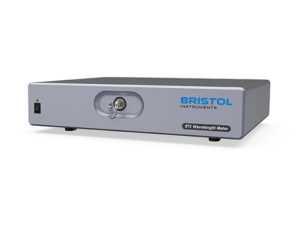
- Measurement resolution up to 200 kHz
- Wavelength accuracy as high as ± 0.0001 nm
- Automatic calibration with a built-in wavelength standard
- Built-in PID controller for precise laser stabilisation
- Operation available from 375 to 1700 nm
- Sustained measurement rate of 1 kHz
- Convenient pre-aligned fibre-optic input
- Straightforward operation via PC using USB or Ethernet
- Automatic data reporting using custom or LabVIEW programming eliminates the need for a dedicated PC
- Optional Fibre-Optic Switch accessory enables the characterisation of up to 8 lasers with a single instrument
- 5-year warranty covers all parts and labour
Moku
Quantum optics made easier
Performing sensitive quantum experiments can be complicated — your equipment shouldn’t be. Easily create, calibrate, measure, and analyse your optical setups, all the way down to the quantum regime.
A test platform you can rely on
Moku devices integrate a full suite of instruments crucial for laser stabilisation and measurement, like the Laser Lock Box, Phasemeter, and Lock-in Amplifier, while providing common test essentials like an Oscilloscope, Spectrum Analyser, and Waveform Generator. Thanks to the software-defined, multi-instrument platform, it’s easy to integrate custom algorithms into your experiments.
Lossless photon counting
Utilise the 4-channel Time & Frequency Analyser to detect individual photon events, generate time interval statistics, and determine correlation functions between channels – all with zero dead time.
Painless laser locking
Easily lock lasers to a cavity using the Laser Lock Box — no manual configuration required. With Lock Assist, you can instantly lock to any zero-crossing on the demodulated error signal.
Custom tools
Use the onboard Moku Cloud Compile to deploy custom signal processing and analysis algorithms directly onto a Moku device’s FPGA, and run them alongside all of your other instruments.
The precision you need, with the flexibility you want
The Moku Phasemeter allows you to visualise multi-channel phase, frequency, and amplitude with microradian precision, all while recording with an embedded data logger.
Engineered for demanding applications.
With Moku:Pro, you have access to multiple pieces of advanced optics instrumentation in one device. Deployed standalone or in Multi-instrument Mode, the Lock-in Amplifier, Laser Lock Box, Phasemeter, and Spectrum Analyser cover applications such as:
- Laser frequency stabilisation with PDH locking
- Mach-Zehnder interferometry
- Broadband frequency detection and analysis
- Hanbury, Brown and Twiss interferometry
Advanced optics and photonics instruments in a single platform
We continually update our software with new features, so your Moku device gets better over time. Check out our latest upgrades for Moku:Lab, Moku:Pro, and Moku:Go to enable multi-window viewing and consistent instrument offerings across the entire Moku product line, strengthen API support, improve the capabilities of multiple software-defined instruments, and support a broader range of use cases for closed-loop control systems, spectroscopy, laser frequency stabilisation, and more.
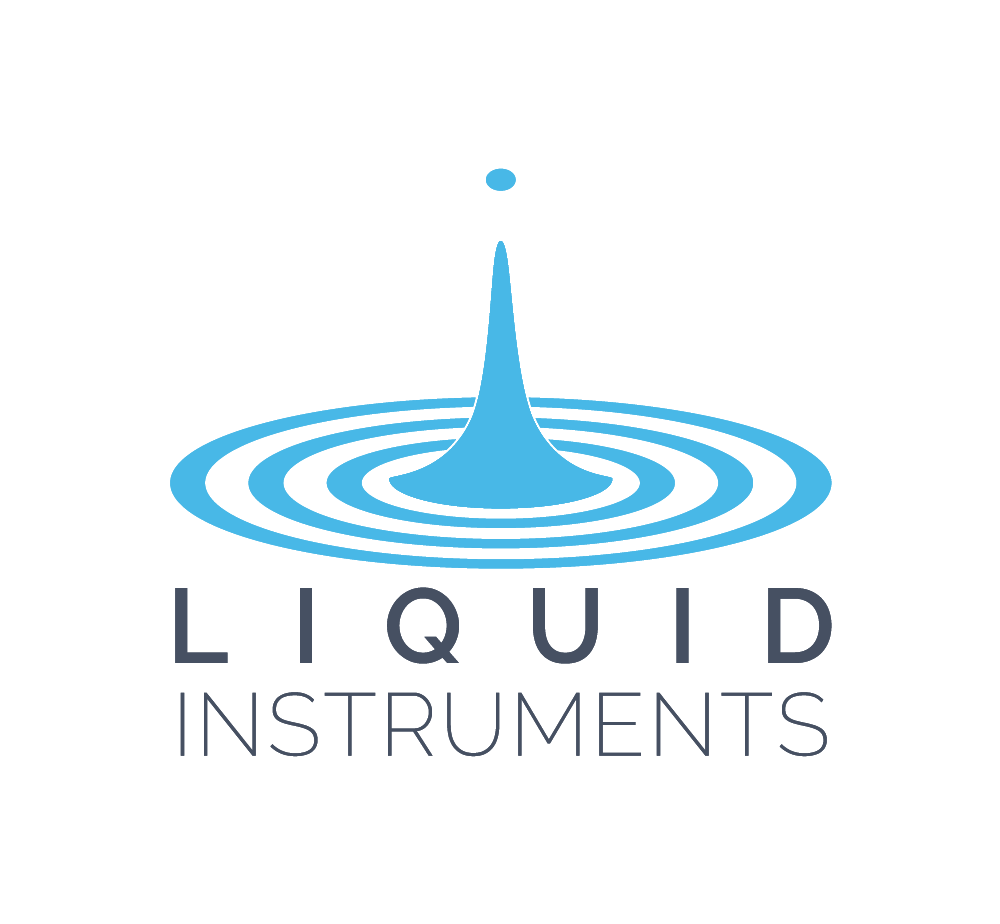

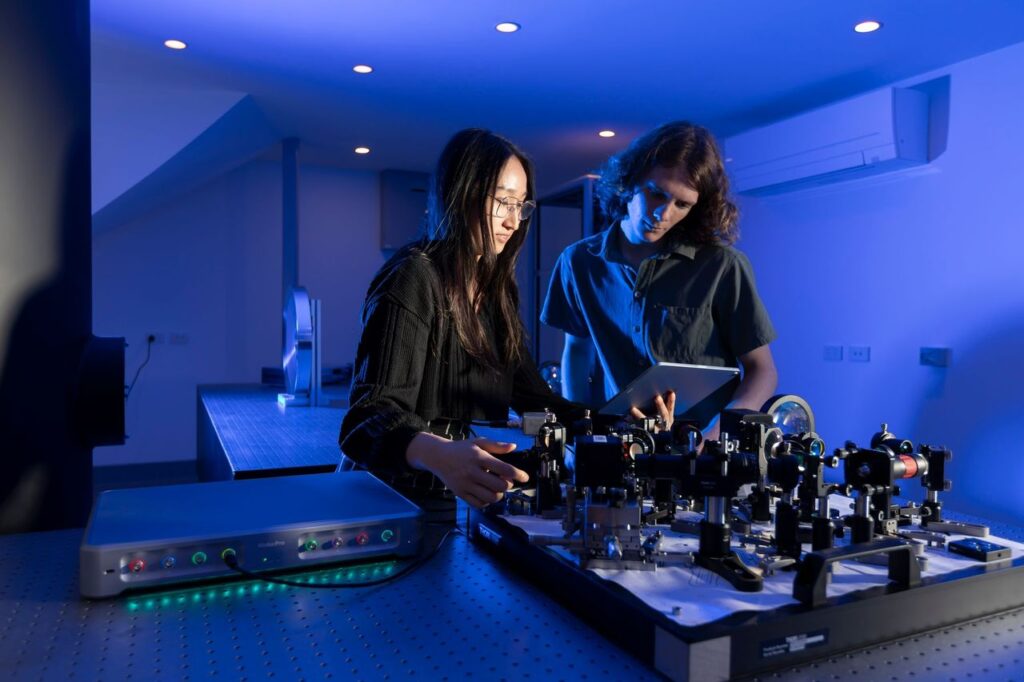
The future of quantum optics testing is software-defined
Quantum optics is an incredibly broad field containing a multitude of active sub-fields. It’s also much older than you might think. Read about areas of active research and how Moku can help with your quantum optics experiments.
Moku in quantum optics experiments
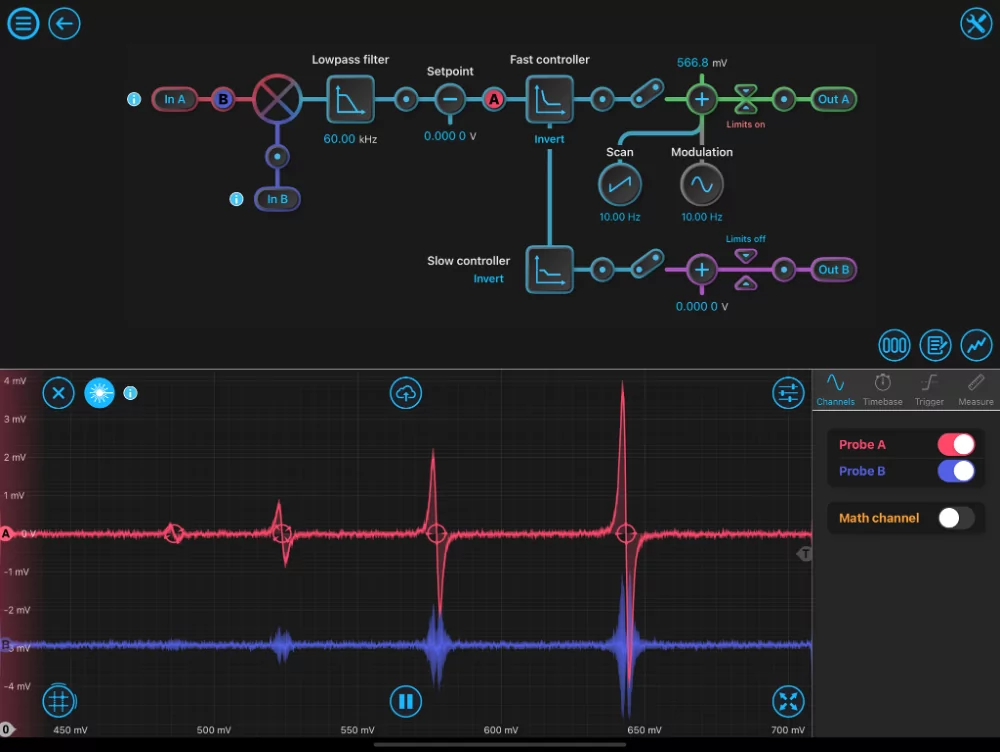
Advancing optical clock performance
Researchers at Humboldt University of Berlin and Ferdinand-Braun-Institut are using a digital-first approach to eliminate tedious manual processes, automate essential tests, and optimise clock stability.
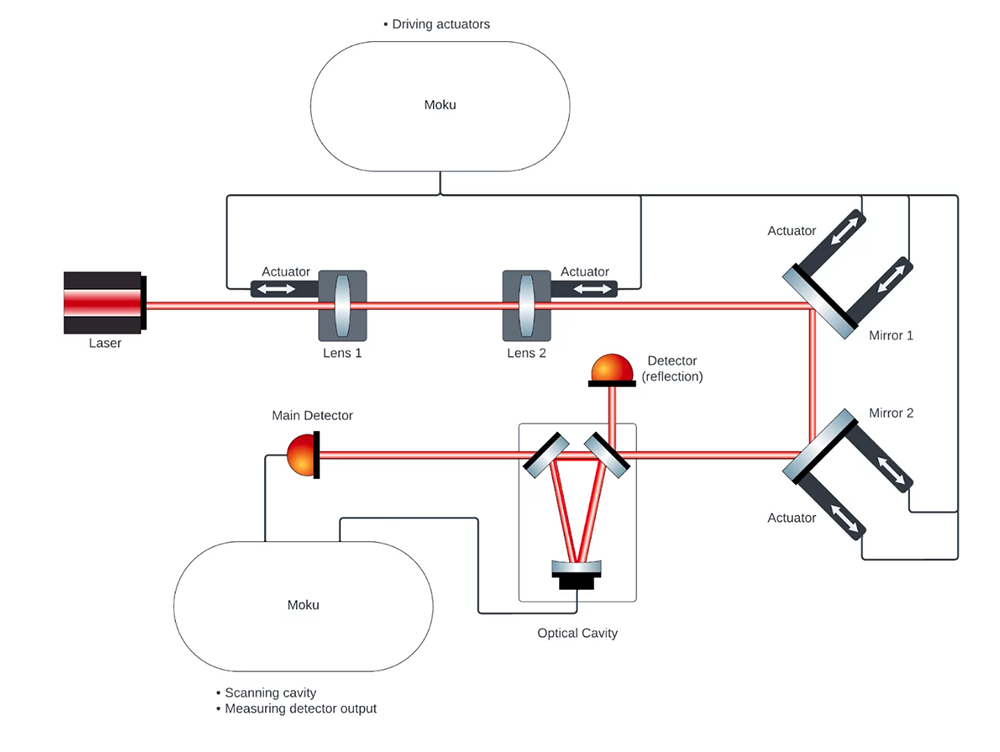
Auto-aligning optical cavity systems with machine learning
Floquet researchers are using software-defined instrumentation to automate laser beam alignment and advance machine learning capabilities to physical systems.

Increasing precision in quantum metrology
A team at Shanghai Jiao Tong University are pushing quantum metrological techniques to their limit using digital lock-in detection and spectrum analysis.
TCSPC and Time Tagging Electronics
MultiHarp 150 High-Throughput Multichannel Event Timer & TCSPC Unit
- 4, 8, or 16 independent input channels
- Common sync channel (up to 1.2 GHz sync rate)
- Highest sustained data throughput (80 Mcps in time tagging mode, 180 Mcps in histogramming mode)
- Ultrashort dead time (650 ps), no dead time across channels
- Ref In/Ref Out/PPS In/White Rabbit interface for multi-device synchronisation
- Drivers & Python wrapper snAPI for seamless communication, configuration, data handling and custom programming
- Multifunctional on-board event filters for “P” versions
HydraHarp 500 High-Resolution Multichannel Event Timer & TCSPC Unit
- Outstanding timing precision of 2 ps RMS for single channel, 3 ps RMS between channels
- Cutting-edge time resolution of 1 ps
- Scalable up to 16+1 channels with advanced channel configuration
- Choice of edge triggers or Constant Fraction Discriminators (CFD) possible
- Sustained time tagging with up to 85 Mcps via USB 3.0 and high speed data link through eFPGA interface
- Ultrashort dead time of 680 ps, no dead time across channels
- Multifunctional on-board event filters
- Ref In/Ref Out/PPS In/White Rabbit interface for multi-device synchronisation
PicoHarp 330 Precise and Versatile Event Timer & TCSPC Unit
PicoHarp 330 is an Event Timer & TCSPC Unit with outstanding timing precision and versatile trigger methods made for applications with up to five channels.
- Outstanding timing precision of 2 ps RMS for single channel, 3 ps RMS between channels
- Cutting-edge time resolution of 1 ps
- Choice of edge triggers or Constant Fraction Discriminators (CFD)
- Sustained time tagging with up to 85 Mcps via USB 3.0
- Ultrashort dead time of 680 ps, no dead time across channels
- Very high precision internal clock source
- Multifunctional on-board event filters
- 4+1 channel setup with advanced channel configuration
TimeHarp 260 TCSPC and MCS board with PCIe interface
- One or two independent input channels and common synch channel (up to 100 MHz)
- Two models with either 25 ps (PICO model) or 250 ps (NANO model) base resolution
- “Long range mode” option for PICO model: 2.5 ns base resolution
- Ultra short dead time (< 25 ns for PICO model, < 2 ns for NANO model)
- Time tagging with sustained count rates up to 40 Mcps
- 32 768 histogram channels
- Adjustable delay on each channel with 25 ps (PICO model) or 250 ps (NANO model) resolution
- Multi-stop capability for efficiency at slow repetition rates
- Programmable trigger output
- External synchronisation signals for (fluorescence lifetime) imaging or other control events for modules with two detection channels
- Python wrapper snAPI for seamless communication, configuration, and data handling (optional drivers needed)s
Single Photon Avalanche Diodes
- Timing resolution down to < 50 ps (FWHM)
- Quantum efficiency 49 % at 550 nm
- Different active areas: 20, 50 and 100 µm
- Ultra stable at high count rates
Applications
- Time-resolved fluorescence
- Fluorescence Lifetime Imaging (FLIM)
- Fluorescence Correlation Spectroscopy (FCS, FLCS, 2fFCS)
- Förster Resonance Energy Transfer (FRET)
- Stimulated Emission Depletion Microscopy (STED)
- Time-Resolved Photoluminescence (TRPL)
- LIDAR, Ranging, SLR
- Quantum optics
The photon counting detector modules of the PDM Series are all solid-state instruments designed and manufactured by Micro Photon Devices (MPD). They feature an excellent photon detection efficiency and superior timing resolution, which is obtained through the use of epitaxial silicon Single Photon Avalanche Diodes (SPAD) and patented integrated Active Quenching Circuits (iAQC). The SPADs are specifically designed and optimised for time-resolved photon counting applications.
Timing resolution down to 50 ps.
The SPADs of the PDM Series generate two output signals – a counting output (TTL signal) and a timing output (NIM signal), which provides better than 50 ps (FWHM) photon timing resolution for a wide range of detection wavelengths. Especially above 470 nm the temporal response is even comparable to MCP-PMTs and an Instrument Response Function (IRF) around 50 ps can be reached with fast TCSPC electronics along with a suited short pulsed laser.
Different active sensor areas
The SPADs are available with a diameter of the active area of 20, 50 or 100 µm, different dark count grades and can be supplied with an easy to use FC/PC connection for optical fibres or as a free-beam module. The PDM SPADs cover a spectral range from about 400 nm to 1000 nm with the highest quantum efficiency in the VIS range around 550 nm. They are extremely robust and can withstand continuous exposition to daylight. The high quantum efficiency make them an ideal detector for single molecule applications, like Fluorescence Correlation Spectroscopy (FCS) or Fluorescence Lifetime Imaging (FLIM), especially as the SPAD output has a stable timing even at count rates exceeding 1 million counts/sec.
Software
snAPI
Fast, Intuitive, and Versatile Python Wrapper
- Download from GitHub for free
- Benefit from seamless communication, configuration, and data handling with PicoQuant’s TCSPC devices
- Access, manipulate, and process raw data stream, or read from file
- Efficiently handle large photon counts with real-time analysis
- Build your own algorithms, implement complex calculations, and develop tailored data processing pipelines directly in Python
QuCoa
Quantum Correlation Analysis Software
- Antibunching (g(2)) measurements including fitting of several models
- Coincidence counting / event filtering using AND, OR, NOT operators
- Preview antibunching curve & correlation data during measurement
- Remote control via TCP/IP Interface
- Calculation of TCSPC histograms and intensity time traces
- Export of all results to ASCII or images
- User programming script language “STUPSLANG”
Quantum Education
Infleqtion’s Cold Atom Platform Tailored for Quantum Education and Workforce Development
As the global quantum ecosystem experiences unprecedented growth, the demand for advanced tools in quantum education and workforce development has become more apparent. Infleqtion, a pioneer in the field of cold atom product technologies, proudly presents a revolutionary platform designed to meet the evolving needs of the quantum education and workforce development markets through experimental interaction with atomic quantum systems.
Addressing Quantum Workforce Challenges:
With an estimated 580,000 jobs projected in quantum-enabled industries by 2040, developing a highly trained and skilled workforce is crucial. However, key roadblocks hinder the commercialisation of quantum technologies, including:
- The need for more user-friendly equipment and teaching tools for quantum matter creation and control
- Essential laser, optic, and photonics skills required for developing cold-atom quantum products
- Experimental measurement analysis and report writing skills that are built into the teaching curriculum
Customer-Inspired Design:
Building upon the success of the award-winning miniMOT V2, desqtopMOT’s compact, modular design seamlessly integrates into any research or teaching laboratory, enabling cold atom applications from entry-level quantum education to advanced experimentation. Its “plug-and-play” setup enhances user accessibility while still inviting exploration and learning about the fundamentals of atomic physics.

Vacuum System
Reliable ultra-high vacuum system, fully contained, portable, and controlled via touchscreen or remote interface.

Atom Source
Proven Rubidium atom source capable of providing atoms for cooling and trapping for years.

Stabilised Laser System
Precision laser system stabilised using a unique spectroscopy cell designed for the desqtopMOT, with offset repump beam for cooling and trapping 87Rb.

Comprehensive Teaching Curriculum
Cold atom quantum curriculum covering cold atom physics, lasers, optics and photonics, and quantum measurements, ensuring a holistic quantum educational experience.

Enabling the Quantum Education and Workforce Ecosystem
The desqtopMOT offers a self-contained platform that can be upgraded over time as users advance their understanding of quantum concepts. Its modular design and operation provide enhanced accessibility, catering to users involved in undergraduate quantum education, workforce training, and development. The desqtopMOT can easily be integrated into corporate R&D laboratories, and can function as a centralised toolkit for quantum research and quantum sensing application development.
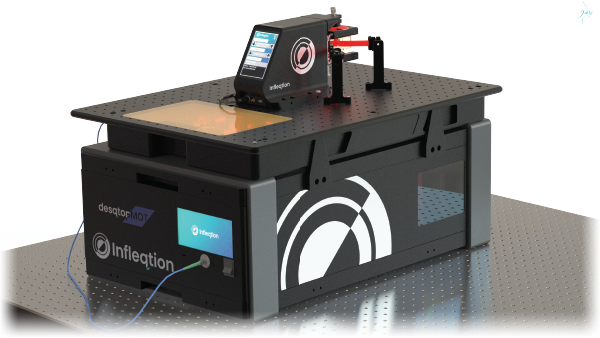

Technical Specifications
- MOT Atomic Species: Rubidium-87
- Vacuum Level: <1 x 10-8 Torr
- Magnetic Field Gradient: 13-14 G/(A-cm)
- Laser Wavelength λ0: 780.241 nm
- Repump λ: λ0+6.4-6.9 GHz
- Laser Power to MOT Cell: 30-50 mW
- Wavelength Tunability : Δλ = ±50 MHz
- Achievable MOT Temperature: <300 μK
- Incident MOT Laser Power: 30-50 mW

Power
110-240 V / 50-60 Hz (Standard electrical power)
Laser & Controls
24 x 21 in. (61 x 53 cm)
Box Dimensions
Height: 8 in. (21 cm)
Physics Package
20 x 28 in. (51 x 71 cm)
Dimensions
Height: 25 cm
Optical
Imperial units, ¼-20 threaded
Breadboard Screw Holes
1 inch grid
Curriculum
Options include a password-protected PDF document or a bound textbook
Explore, Educate, Empower
Boost your Quantum Teaching Potential
The desqtopMOT re-imagines how atom-based quantum is taught and enables users to learn the fundamentals in:
- Atomic physics
- The nature of and properties of light
- Laser operation, beam delivery and optimisation
- Geometrical optics
- Vacuum engineering and science
- Magneto-optical trapping of atoms
- Characterisation of cold atoms
- Explore unique properties of cold atom ensembles such as Faraday rotation
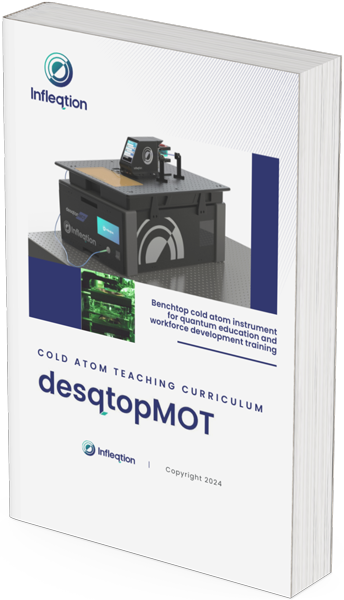

Teaching Curriculum
The desqtopMOT unites, in one product, the hardware and teaching materials missing in today’s Quantum Information Science and Engineering (QISE) education ecosystem. Our approach has been to create a teaching curriculum that is accessible to all; 4-year and 2-year undergraduates, graduates, industry scientists and engineers.
To capture emerging needs in quantum education, our curriculum includes:
Base Model
Chapter 1: Introductory Atomic Physics
Atomic structure and energy levels
Chapter 2: desqtopMOT User Manual
Experimental setup with your desqtopMOT system
Chapter 3: Optics for Atomic Physics
Measurement of input light characteristics
Chapter 4: Experiments with Thermal Atoms
Spectroscopy of 87Rb energy level transitions
Chapter 5: Laser Cooling Part 1
Create and measure a MOT of 87Rb atoms!
Advanced
Chapter 6: Laser Cooling Part 2
Compress, sub-Doppler cool and image atoms in the MOT cloud
Chapter 7: Experiments with Cold Atoms
Measure Faraday rotation and demonstrate
Electronically Induced Transparency (EIT)
